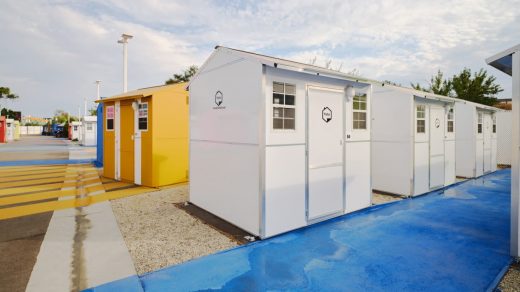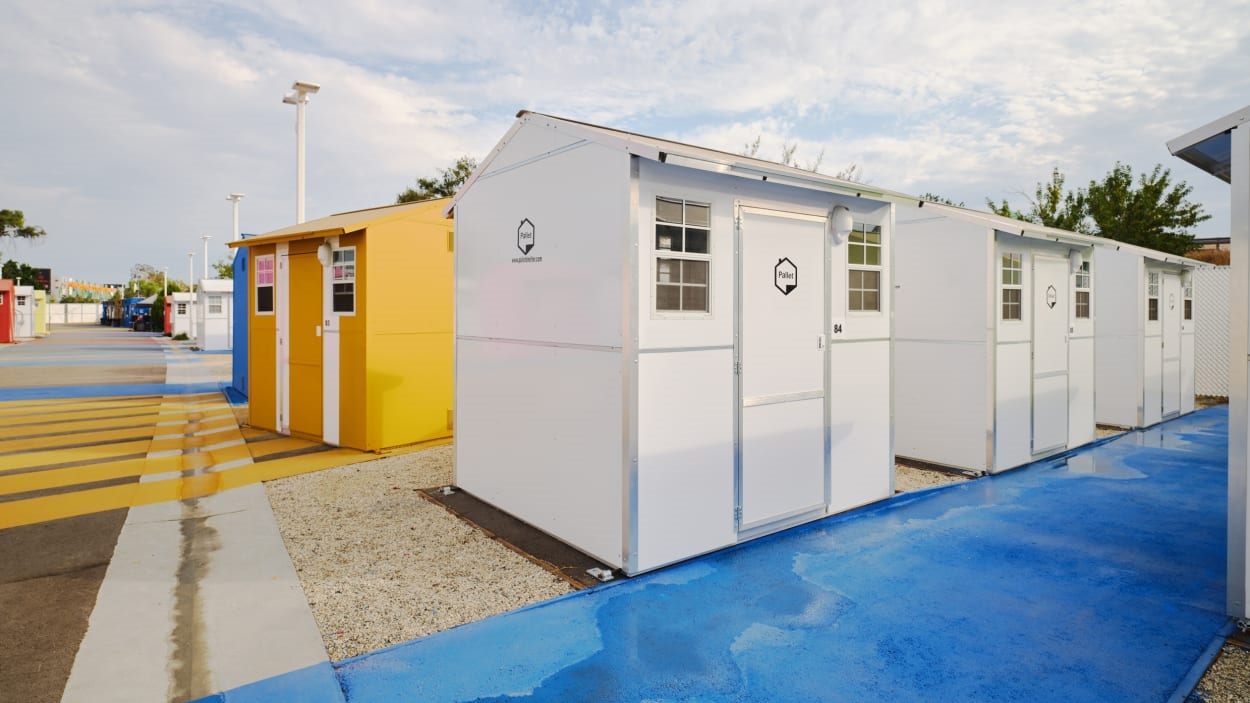Can these ‘micro shelters’ help Birmingham’s chronically homeless population transition to housing?
Of the 950 or so homeless people in Birmingham, Alabama, in 2022, about two-thirds were chronically homeless. That means they aren’t people who’ve recently been served eviction notices and are getting back on their feet soon, but rather individuals without housing for more than a year, often because they’re suffering from a condition like a physical disability, mental health issue, or substance abuse.
To support those most vulnerable people, Alabama’s largest city is launching a temporary housing pilot for some of its homeless population. It will construct small villages of “micro shelters” for people to reside in while they seek more permanent places to live.
These shelter communities exist throughout the U.S., but current providers say they haven’t been a cure-all for homelessness. Some people aren’t ready to live in them, others need sufficient time in the shelters to adjust, and housing alone is often not enough; they recommend focusing equally on wraparound services as a more holistic solution. Birmingham is recruiting experienced local nonprofits to guide them in effectively incorporating these services, from support for mental health and drug abuse to assistance in gaining healthcare and employment. The hope is to simultaneously convince the wider community that the shelters are a net positive for the city.
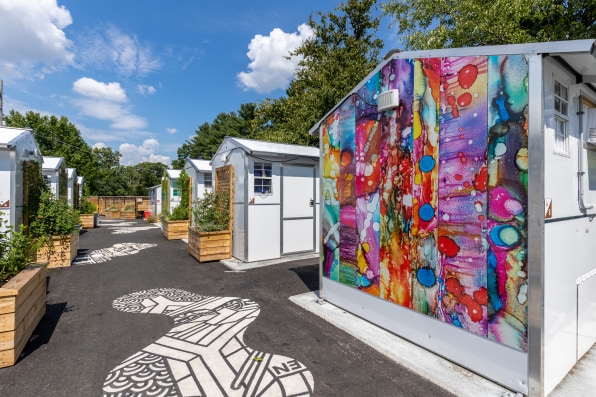
“Shelter is really critical to folks being able to transition and live healthy lives,” says Meghan Venable-Thomas, Birmingham’s director of community development. Announced by Mayor Randall Woodfin, the Home for All program will be a 12-month pilot to house chronically homeless individuals, financed by a federal community development block grant. The $975,000 will cover 50 “cabin” shelters, plus five accessible bathrooms, three community rooms, and their operations.
Pallet, the company that manufactures the small shelters, has its cabins in sites around the country, though mostly in the West. Pallet says the 8-by-8-foot shelters are durable for up to 10 years and resistant to the elements; they contain smoke detectors, locks, gutters, and LED lighting, as well as insulation and heating and cooling elements. Birmingham’s will each be fitted with a bed and desk.
“Not all places that are affordable have to also be of low quality,” Venable-Thomas says. “We can have beautiful, well-designed, happy homes that are also affordable.”
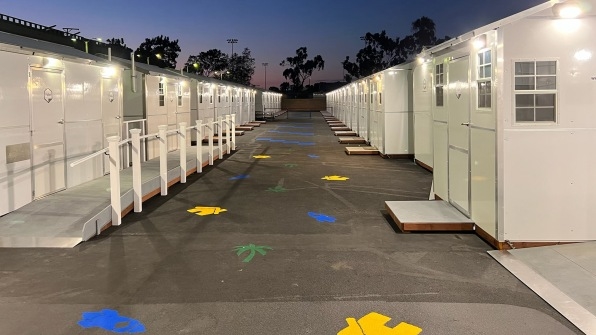
Pallet chooses its terminology carefully to describe the transitional nature of its products. “We’re very clear: This is not a home,” says Katya Hill, the company’s director of marketing and communications. “It looks like a shelter. We don’t want it to look like a tiny home, because it’s not a home.”
That differentiates the shelters from self-described tiny homes elsewhere, like in Austin’s Community First! Village, where 3D-printed homes are stocked with a fridge and microwave and designed to the residents’ color palette tastes. Boasting a community cinema, market, and walking trails, the village is designed to be a community, not a place to transition. In contrast, Pallet’s structures are purposely built for quick deployment—a cabin can be erected in less than two hours
Alone, they won’t be enough; the shelters do not solve homelessness, Hill says. Past pilots have learned that they need to be complemented with services that tend to basic needs like water access, security, and transportation, as well as mental health services, employment development, and treatment for drug abuse help. “You need to be providing an ecosystem of care that is holistic to support people,” she says.
That was a key takeaway for a pilot in Everett, Washington, a city in Seattle’s metropolitan area, and where Pallet’s headquarters are located. Everett was dealing with the effects of Seattle’s homelessness surge, exacerbated by the opioid and fentanyl public health crisis.
“[The pilot] hasn’t been as easy as we would have hoped,” says Julie Willie, Everett’s community development director. The early pilots, which provided 40 shelters, largely focused on the housing aspect alone. Willie says they learned that a “high level of services” are needed in order for the programs to be successful.
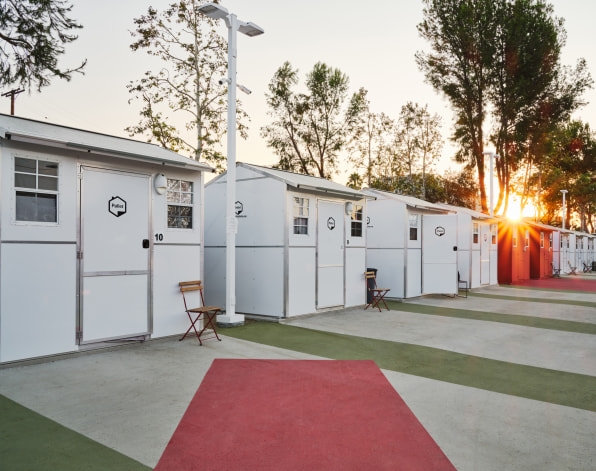
For its next iterations, Everett will specifically house families and single mothers with young children, and they will be “service-focused.” They aim to give temporary residents enough time to get stabilized, which is crucial for people who’ve been homeless for 5 to 10 years to adjust and feel safe before focusing on life goals—including the challenge of finding affordable permanent housing, which is not easy.
For that reason, Birmingham’s pilot is not expected to begin until May, to make time for planning wraparound services as a major part of its program. On Tuesday, the mayor presented the project at a City Council meeting to various community service providers; these nonprofits will submit proposals of their services to the mayor’s office. The idea is to allow those expert providers to lead, Venable-Thomas says. “We’re flipping it so that we’re responding to their needs,” she says.
Pallet communities have had some successes. Shelters in Vancouver, Washington, on the Oregon border, have served 46 people, with an average-length stay of 130 days; in the six months from December 2021, 14 had successful transitions into permanent housing, 11 secured employment, 32 accessed healthcare, and 6 got detox services. Calls to the police about the shelter community dropped by 30% compared to the year prior, when the site was a homeless encampment.
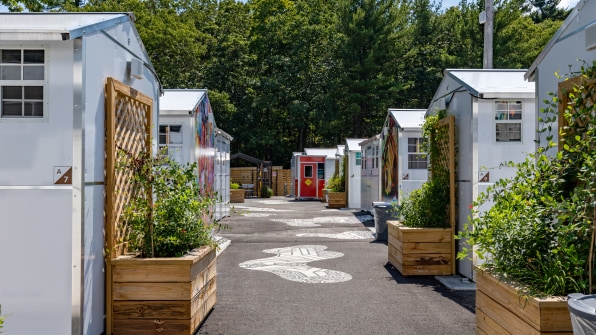
Part of this comes from building a neighborhood feel, which is part of Pallet’s mission. The company calls the clusters of shelters “villages” and recommends at least six on a site to foster that sense of community. Birmingham will place 8 to 15 shelters together.
That’s a nice ideal, but not always possible. Everett passed a “no sit, no lie” ordinance in its Pallet village, barring the shelter residents from congregating outside, on penalty of a $500 fine or 90 days in jail. The site is in an industrial district where business owners were wary of previous problems of public disturbance in the encampment, which ran “the whole gamut of really challenging behaviors,” Willie says, including public defecation, burglary, trespassing, and damage to buildings. The council saw the ordinance as a necessary step in order to be able to house the people in the shelters while keeping the broader community appeased.
Venable-Thomas is prepared for such challenges in Birmingham. “We deal with NIMBYism, as they say, across the work that we do here in community development and affordable housing,” she says.
In her experience, it’s best to bring the community into the fold, allow them to voice concerns, and present facts to them: chiefly, that people deserve the dignity of housing. “Ultimately, that’s what all residents want,” she says. “That’s what we want for each other. That’s really what people deserve.”
(7)

